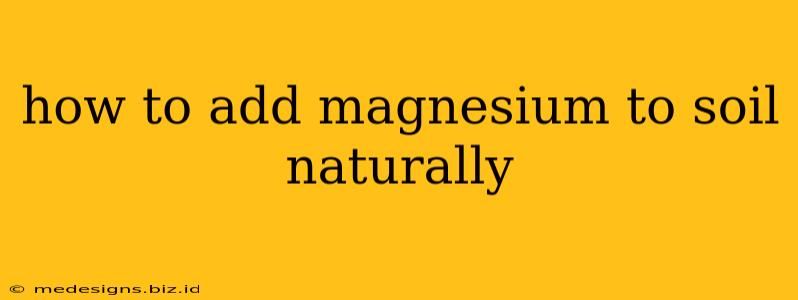Magnesium is a vital nutrient for healthy plant growth, playing a crucial role in photosynthesis and chlorophyll production. Magnesium deficiency can lead to stunted growth, yellowing leaves, and reduced yields. Fortunately, there are several natural ways to increase magnesium levels in your soil without resorting to harsh chemical fertilizers. This guide explores effective and eco-friendly methods for boosting magnesium in your garden.
Understanding Magnesium Deficiency in Plants
Before diving into solutions, it's important to understand the signs of magnesium deficiency. Common symptoms include:
- Chlorosis: Yellowing of the leaves, often starting at the older leaves and progressing inwards. The leaf veins may remain green.
- Necrosis: Browning and dying of leaf tissue.
- Stunted Growth: Plants may appear smaller and weaker than normal.
- Reduced Yields: Fruit and vegetable production can be significantly impacted.
If you suspect magnesium deficiency, a soil test can confirm the diagnosis and determine the severity of the problem.
Natural Ways to Add Magnesium to Your Soil
Several natural methods effectively increase magnesium levels in your soil, promoting healthy plant growth. Here are some of the most effective:
1. Epsom Salt: A Quick and Easy Solution
Epsom salt (magnesium sulfate) is a readily available and inexpensive source of magnesium. It's a simple and effective way to provide a quick boost of magnesium to your plants.
- Application: Dissolve Epsom salt in water (about 1 tablespoon per gallon) and apply it to the soil around your plants. You can also foliar feed by spraying the solution directly onto the leaves.
- Frequency: Apply every 2-4 weeks, depending on the severity of the deficiency and soil type.
- Caution: Overuse can lead to salt buildup in the soil, so follow recommended application rates.
2. Dolomite Lime: A Long-Term Solution
Dolomite lime is a natural mineral containing both magnesium and calcium. It's a slower-releasing source of magnesium than Epsom salt, providing a more sustained benefit.
- Application: Spread dolomite lime evenly over the soil surface and till it in. The application rate will depend on your soil's pH and magnesium levels, so a soil test is recommended.
- Frequency: Dolomite lime is typically applied once every few years, as needed.
- Benefit: Improves soil structure and pH in addition to providing magnesium.
3. Compost and Organic Matter: The Holistic Approach
Compost and other organic matter are excellent sources of various nutrients, including magnesium. Adding compost to your garden improves soil health overall, promoting better nutrient uptake.
- Application: Incorporate compost into your garden beds before planting or as a top dressing.
- Frequency: Regular addition of compost is beneficial for long-term soil health.
- Benefit: Improves soil structure, water retention, and overall nutrient availability.
4. Seaweed Extracts: A Natural Plant Tonic
Seaweed extracts are rich in magnesium and other essential nutrients. They are a natural and effective way to boost magnesium levels and improve plant health.
- Application: Dilute seaweed extract according to the manufacturer's instructions and apply it to the soil or as a foliar spray.
- Frequency: Apply every 2-4 weeks, as needed.
- Benefit: Provides a balanced supply of nutrients and improves plant stress tolerance.
5. Wood Ash: A Source of Magnesium and Potassium
Wood ash from hardwood trees contains magnesium, potassium, and other minerals. However, use caution: ash can be alkaline and raise the soil's pH. A soil test is essential before using wood ash.
- Application: Sprinkle wood ash lightly around plants, avoiding direct contact with the foliage.
- Frequency: Apply sparingly, only if needed, based on soil test results.
- Caution: Overuse can raise soil pH and harm plants sensitive to alkalinity.
Choosing the Right Method
The best method for adding magnesium to your soil depends on your specific needs and soil conditions. Consider these factors:
- Severity of Deficiency: For a severe deficiency, Epsom salt provides a quick fix.
- Long-Term Solution: Dolomite lime offers a more sustained release of magnesium.
- Overall Soil Health: Compost and organic matter improve soil health comprehensively.
- Soil pH: Wood ash can raise soil pH, so use with caution and only after testing.
Remember to always perform a soil test to determine the precise needs of your soil and plants. By following these natural methods, you can ensure your plants receive the magnesium they need to thrive, resulting in a healthier and more productive garden.
